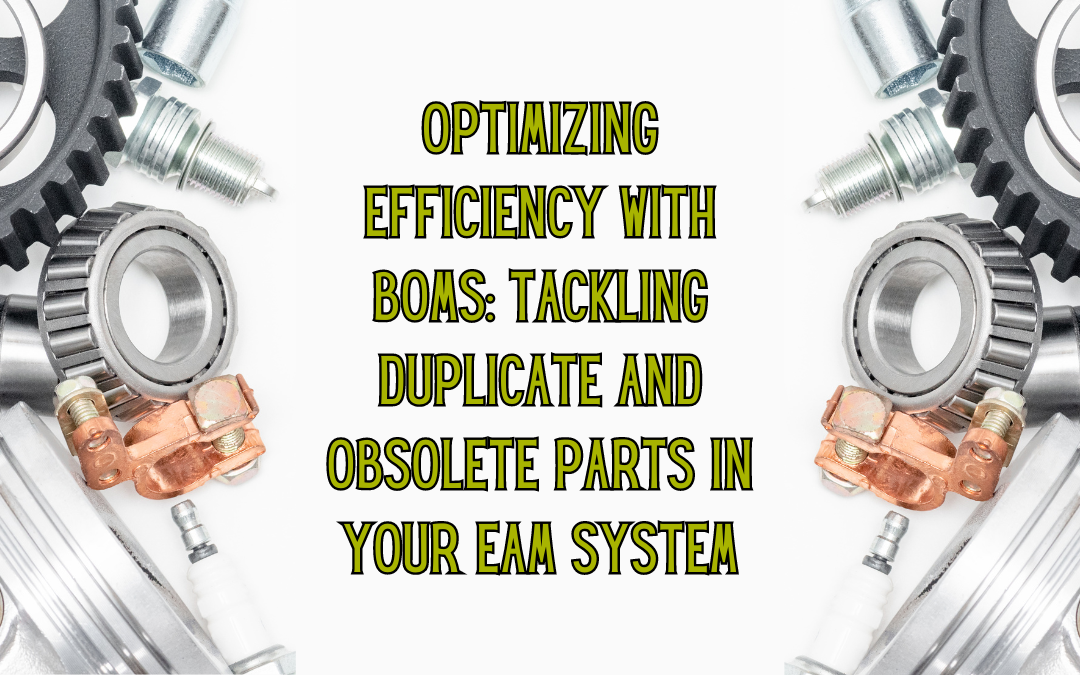Efficient Enterprise Asset Management (EAM) is pivotal for the smooth operation of any organization. However, challenges arise when duplicate and obsolete parts clutter the system, leading to inefficiencies. In this blog, we’ll explore the intricacies of dealing with duplicate parts in EAM systems, the consequences of inclusion, and the challenges associated with identifying and eliminating these duplicates or obsolete parts.

- The Culprit: Inclusion of Interchangeable Parts Multiple Times:
- Duplicity Dilemma: Existing processes often result in the inclusion of interchangeable parts in the EAM system multiple times, creating unnecessary duplicates. This duplicity can stem from various sources, including manual data entry errors, lack of standardized part identification, or inability to search existing parts effectively.
- Consequences of Duplicates: The inclusion of duplicate parts can lead to confusion, skewed inventory management, and inefficient resource allocation. It complicates maintenance procedures, potentially causing delays and increasing the risk of errors.
- The Challenge: Identifying and Eliminating Duplicates or Obsolete Parts:
- Challenges in Identification: Identifying duplicate or obsolete parts within the EAM system poses a significant challenge. The sheer volume of data, coupled with variations in naming conventions or part specifications, makes it difficult to pinpoint duplicates accurately. A key challenge is the inability to search effectively for spare parts in the system.
- Time-Consuming Cleanup Process: Once identified, the cleanup process is time-consuming. Manually reviewing each part, cross-referencing databases, and ensuring the accurate removal of duplicates demands precise attention to detail and substantial time investments. Care must be taken to ensure that every reference in the EAM/CMMS to duplicate parts is replaced with an appropriate new part. This could include BoMs but also PMs and other data in the EAM/CMMS.
- Strategies for Efficient Cleanup:
To tackle the issue of duplicate and obsolete parts, organizations can adopt strategic measures:
- Data Standardization: Implement standardized naming conventions and part identification protocols to minimize the chances of duplicates entering the system.
- Regular Audits: Conduct periodic audits of the EAM system to proactively identify and address duplicate or obsolete parts. Automation tools can streamline this process.
- Collaborative Communication: Foster open communication between maintenance teams, procurement, and other relevant departments to ensure accurate data entry and reduce the likelihood of duplicity.
- Utilize Automation Tools: Leverage advanced automation tools and software solutions designed to identify, flag, and eliminate duplicate or obsolete parts efficiently.

Inefficient EAM systems can hinder overall asset management performance. Addressing the challenge of duplicate and obsolete parts requires a strategic and proactive approach. By implementing standardized protocols, conducting regular audits, fostering collaboration, and leveraging automation tools, organizations can streamline their EAM systems, optimize resource allocation, and ensure that duplicate and obsolete parts no longer impede operational efficiency. In the quest for a well-oiled EAM system, the elimination of duplicity is a strategic move towards enhanced productivity and streamlined asset management.
How Can We Help You?
Hubhead’s solutions and services can assist in preventing the occurrence of duplicate parts in your system. To learn more about how we can help you, contact us to book a demo or download our brochure.
Why Maintenance BOMs Need to be Accurate
Tips To Create Good Quality Maintenance BOMs
Signs you should start building a BOM
Share this article




